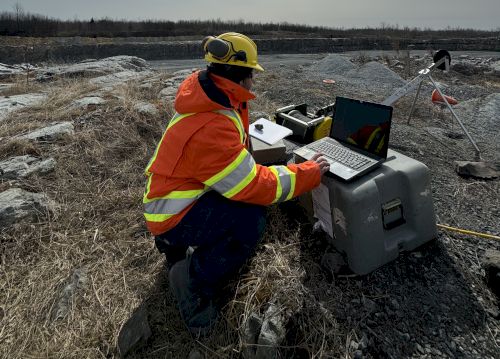
Geomechanics Research
Rock Characterization
Rock Stress
Numerial Modelling
Rock Support
Mining Induced Seismicity
Overview
Our Focus
Rock Characterization
- Drift mapping for rock mass classification according to RMR, Q or GSI systems.
- Borehole logging using optical or acoustic televiewers and full-waveform sonic logger.
- Lab measurement of strength and deformation characteristics according to ASTM or ISRM standards.
- Drillability assessment according to tests developed at Norwegian Institute of Technology and those developed at the Laboratoire du Centre d’Études et Rechèrches des Charbonnages de France (CERCHAR).
Rock Stress
- Field measurements of the in situ stress state by overcoring using either triaxial CSIRO stress cells or the USBM borehole deformation gauge.
- Back-analysis/constraining of the stress state from excavation/borehole response measurements.
- Critical review of existing measurement database.
Numerial Modelling
2 & 3D modelling of excavations, both surface and underground, for predictions of stability and performance under prescribed conditions.
Rock Support
- Static and impact testing of support components or systems following recognized procedures.
- Design and implementation of assessment procedures/techniques for application to new support technologies.
- Evaluation of current support measures.
- Support selection for application under dynamic loading (blasting, induced seismicity).
Mining Induced Seismicity
- Development of site-specific interpretations of seismic activity to enable mitigation strategies to be implemented to improve safety and ensure the economic viability of operations at depth.
- Seismic Excavation Hazard Map — tool developed at MIRARCO using the ParaviewGeo visualization platform to facilitate understanding of the impact of mining induced seismicity.
Featured Projects
Hydraulic Preconditioning
To demonstrate that hydraulic-preconditioning can alter the character of the rock mass such that the maximum magnitude of mining induced seismic events can be reduced in highly stressed ground.
The technology has been successfully employed for such purposes at El TenienteMine in Chile; however, in an environment characterized by lower stresses and weaker rock.

Highlights
BurstSupport is the first of its kind for the mining industry.
BurstSupport encapsulates the design logic from the Canadian Rockburst Support Handbook (Kaiser et al., 1996) and integrates many recent research outcomes.
BurstSupport is a powerful standalone, Windows based 3D tool designed and developed by MIRARCO for mining or civil engineers to conduct rock support design in deep underground mine drifts or civil tunnels.
MIRARCO at Laurentian University is releasing the manuscript of a <Rockburst Support Reference Book> consisting of three volumes:
- Rockburst phenomenon and support characteristics
- Rock support to mitigate strainburst damage caused by dynamic excavation failures (under preparation)
Dr. Peter K Kaiser is a specialist in applied research for underground construction and mining with primary interests in rock engineering, rock support in burstprone ground, mine design and the application of innovative technologies to increase mine safety and productivity. He brings extensive experience from both the industrial and academic sectors, having served as consultant to numerous consulting companies, mines, and public agencies.




